JEEP GRAND CHEROKEE 2004 WK / 3.G Owners Manual
Manufacturer: JEEP, Model Year: 2004, Model line: GRAND CHEROKEE, Model: JEEP GRAND CHEROKEE 2004 WK / 3.GPages: 344, PDF Size: 6.09 MB
Page 211 of 344
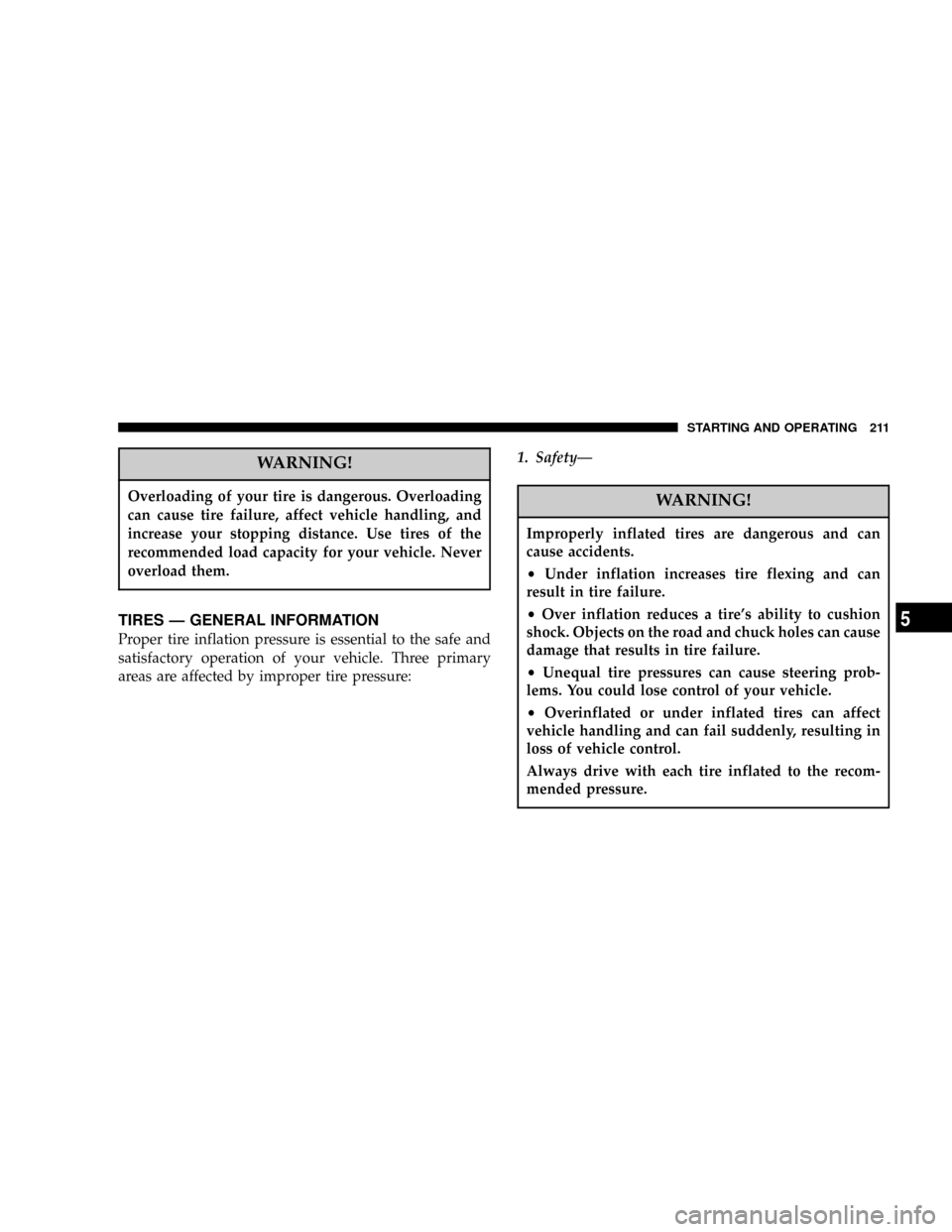
WARNING!
Overloading of your tire is dangerous. Overloading
can cause tire failure, affect vehicle handling, and
increase your stopping distance. Use tires of the
recommended load capacity for your vehicle. Never
overload them.
TIRES Ð GENERAL INFORMATION
Proper tire inflation pressure is essential to the safe and
satisfactory operation of your vehicle. Three primary
areas are affected by improper tire pressure:1. SafetyÐ
WARNING!
Improperly inflated tires are dangerous and can
cause accidents.
²Under inflation increases tire flexing and can
result in tire failure.
²Over inflation reduces a tire's ability to cushion
shock. Objects on the road and chuck holes can cause
damage that results in tire failure.
²Unequal tire pressures can cause steering prob-
lems. You could lose control of your vehicle.
²Overinflated or under inflated tires can affect
vehicle handling and can fail suddenly, resulting in
loss of vehicle control.
Always drive with each tire inflated to the recom-
mended pressure.
STARTING AND OPERATING 211
5
Page 212 of 344

2. EconomyÐ
Improper inflation pressures can cause uneven wear
patterns to develop across the tire tread. These abnormal
wear patterns will reduce tread life resulting in a need for
earlier tire replacement. Under inflation also increases
tire rolling resistance and results in higher fuel consump-
tion.
3. Ride Comfort and Vehicle StabilityÐ
Proper tire inflation contributes to a comfortable ride.
Over inflation produces a jarring and uncomfortable ride.
Both under inflation and over inflation affect the stability
of the vehicle and can produce a feeling of sluggish
response or over responsiveness in the steering.
Unequal tire pressures can cause erratic and unpredict-
able steering response.
Unequal tire pressure from side to side may cause the
vehicle to drift left or right.Tire Inflation Pressures
The proper cold tire inflation pressure for passenger cars
is listed on either the face of the driver's door or the
driver's side ªBº pillar. For vehicles other than passenger
cars, the cold tire inflation pressures are listed on either
the ªBº pillar or the Certification Label.
212 STARTING AND OPERATING
Page 213 of 344
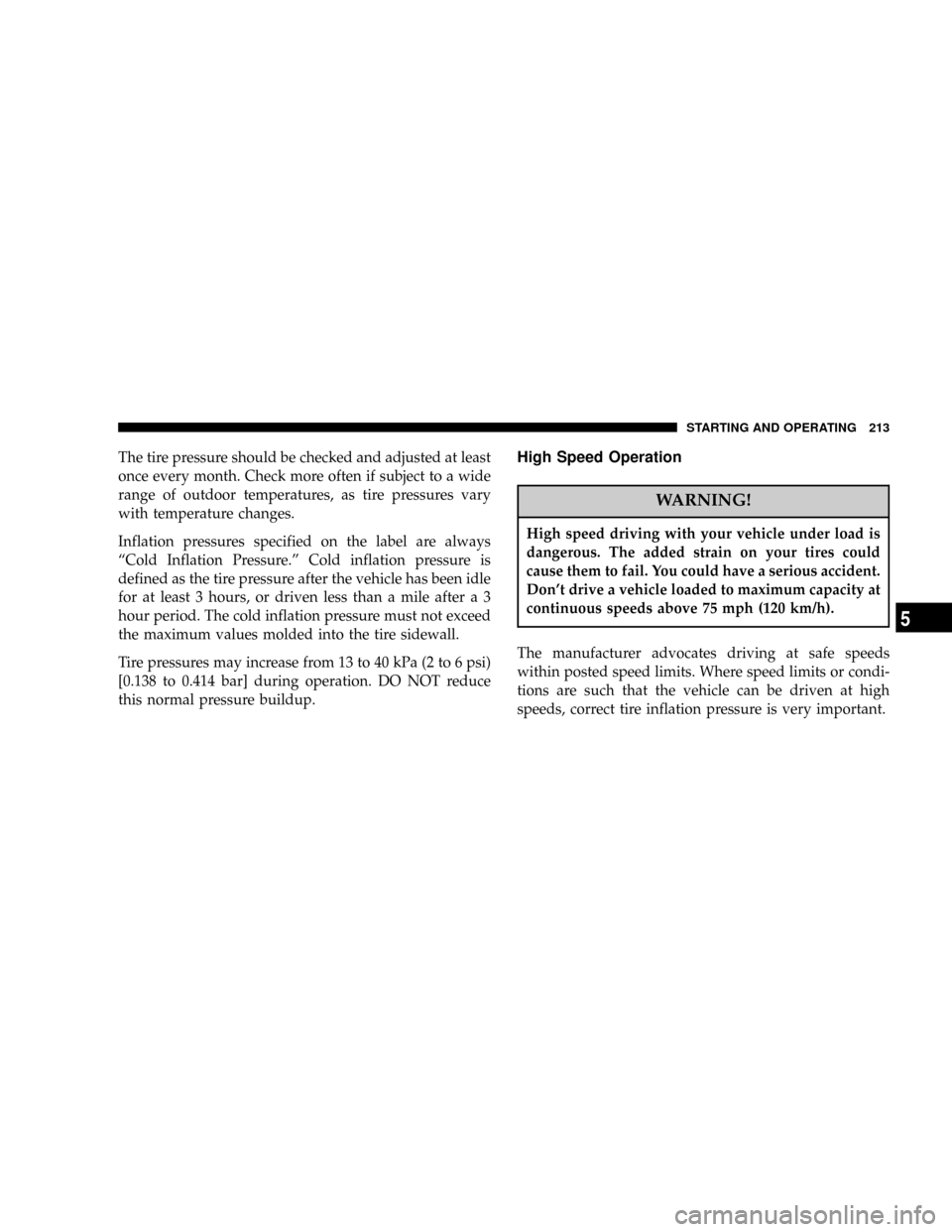
The tire pressure should be checked and adjusted at least
once every month. Check more often if subject to a wide
range of outdoor temperatures, as tire pressures vary
with temperature changes.
Inflation pressures specified on the label are always
ªCold Inflation Pressure.º Cold inflation pressure is
defined as the tire pressure after the vehicle has been idle
for at least 3 hours, or driven less than a mile after a 3
hour period. The cold inflation pressure must not exceed
the maximum values molded into the tire sidewall.
Tire pressures may increase from 13 to 40 kPa (2 to 6 psi)
[0.138 to 0.414 bar] during operation. DO NOT reduce
this normal pressure buildup.High Speed Operation
WARNING!
High speed driving with your vehicle under load is
dangerous. The added strain on your tires could
cause them to fail. You could have a serious accident.
Don't drive a vehicle loaded to maximum capacity at
continuous speeds above 75 mph (120 km/h).
The manufacturer advocates driving at safe speeds
within posted speed limits. Where speed limits or condi-
tions are such that the vehicle can be driven at high
speeds, correct tire inflation pressure is very important.
STARTING AND OPERATING 213
5
Page 214 of 344
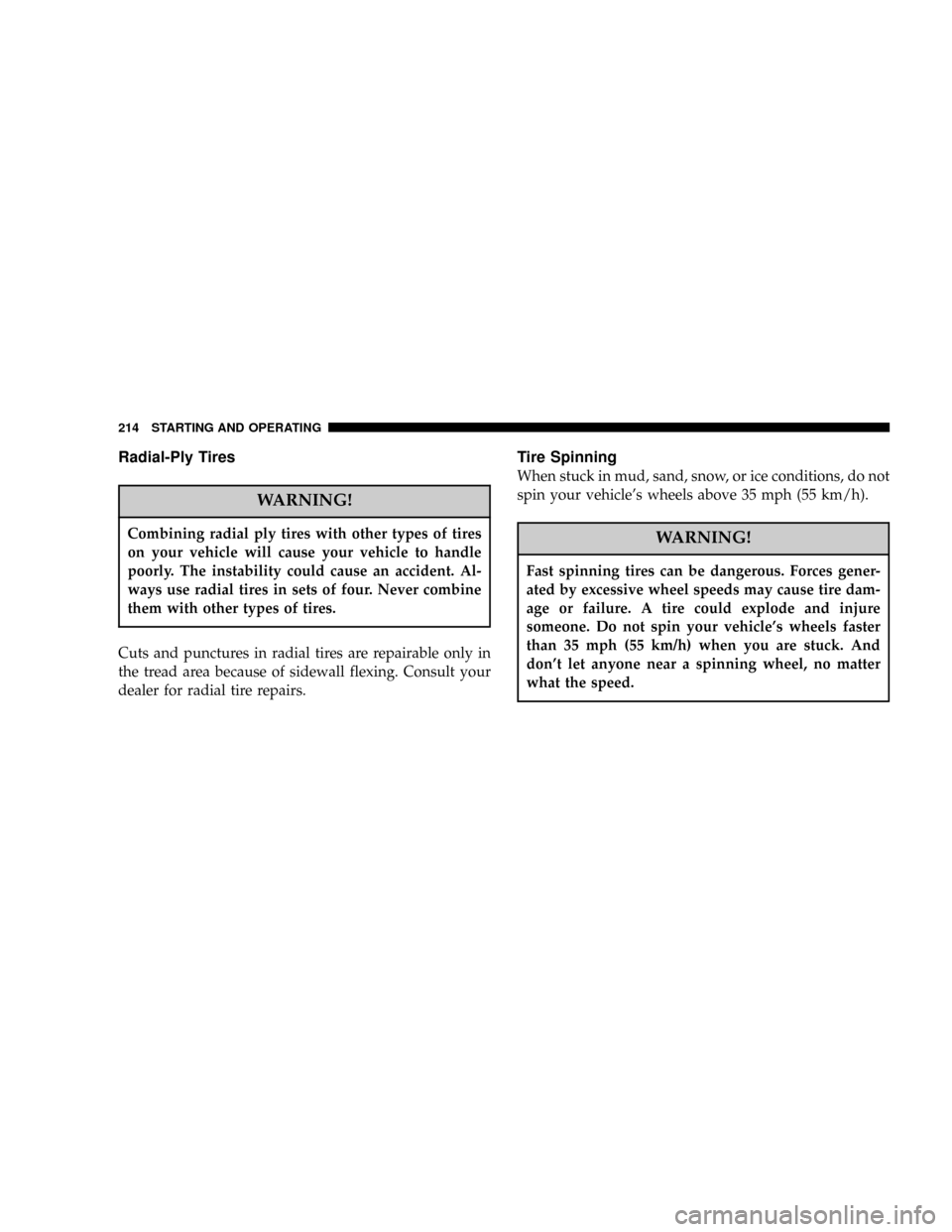
Radial-Ply Tires
WARNING!
Combining radial ply tires with other types of tires
on your vehicle will cause your vehicle to handle
poorly. The instability could cause an accident. Al-
ways use radial tires in sets of four. Never combine
them with other types of tires.
Cuts and punctures in radial tires are repairable only in
the tread area because of sidewall flexing. Consult your
dealer for radial tire repairs.
Tire Spinning
When stuck in mud, sand, snow, or ice conditions, do not
spin your vehicle's wheels above 35 mph (55 km/h).
WARNING!
Fast spinning tires can be dangerous. Forces gener-
ated by excessive wheel speeds may cause tire dam-
age or failure. A tire could explode and injure
someone. Do not spin your vehicle's wheels faster
than 35 mph (55 km/h) when you are stuck. And
don't let anyone near a spinning wheel, no matter
what the speed.
214 STARTING AND OPERATING
Page 215 of 344

Tread Wear Indicators
These indicators are narrow strips 1/16 inch (1.6 mm)
thick and are found in the tread pattern grooves.
When the tread pattern is worn down to these treadwear
indicators, the tires should be replaced.
Overloading your vehicle, long trips in very hot weather,
and driving on bad roads may result in greater wear.
Replacement Tires
The tires on your new vehicle provide a balance of many
characteristics. They should be inspected regularly for
wear and correct inflation pressure. The manufacture
strongly recommends that you use tires equivalent to the
originals in quality and performance when replacement
is needed (see section on tread wear indicators). Failure
to use equivalent replacement tires may adversely affect
the safety, handling, ride and fuel economy of your
vehicle. We recommend that you contact your original
equipment tire dealer on any questions you may have on
tire specifications or capability.
STARTING AND OPERATING 215
5
Page 216 of 344
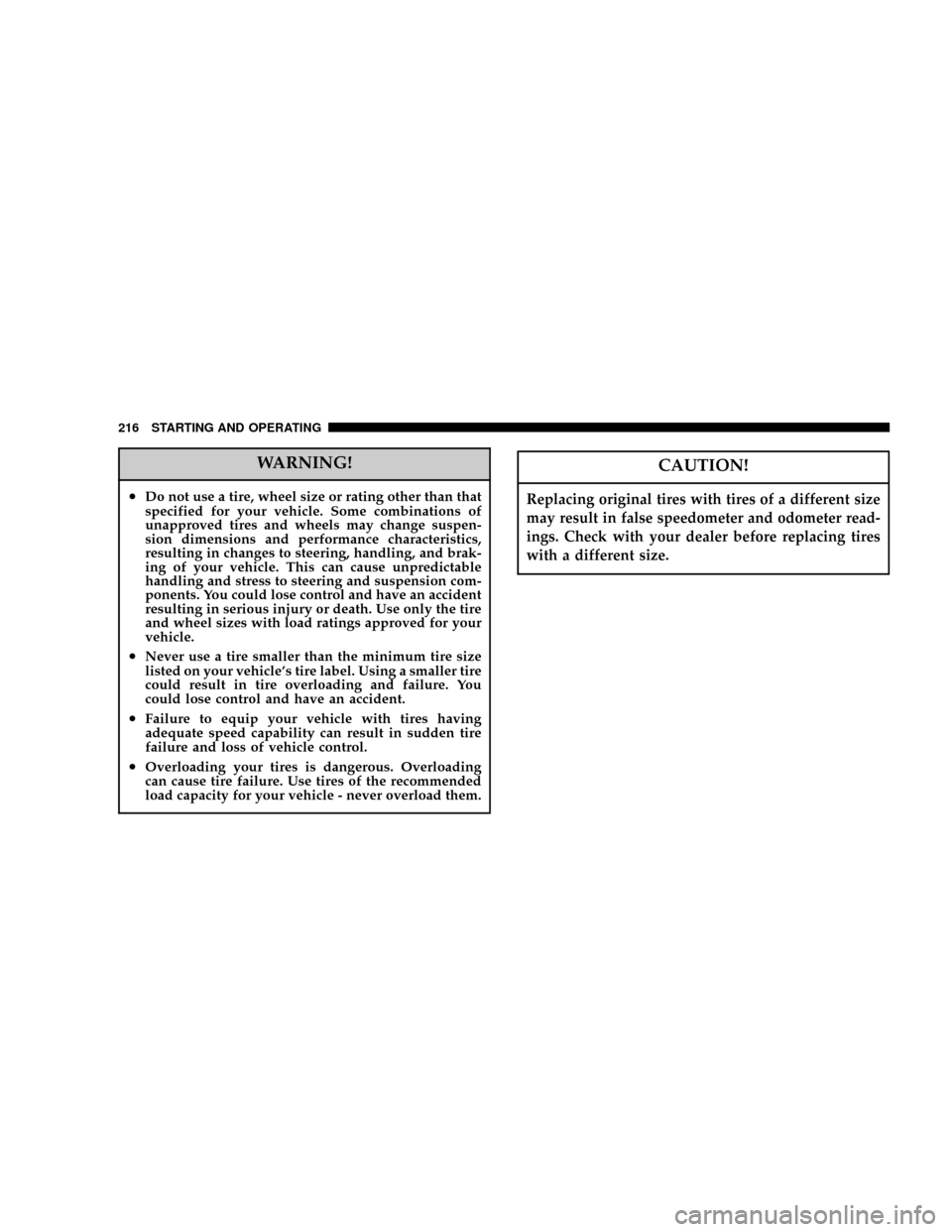
WARNING!
²Do not use a tire, wheel size or rating other than that
specified for your vehicle. Some combinations of
unapproved tires and wheels may change suspen-
sion dimensions and performance characteristics,
resulting in changes to steering, handling, and brak-
ing of your vehicle. This can cause unpredictable
handling and stress to steering and suspension com-
ponents. You could lose control and have an accident
resulting in serious injury or death. Use only the tire
and wheel sizes with load ratings approved for your
vehicle.
²Never use a tire smaller than the minimum tire size
listed on your vehicle's tire label. Using a smaller tire
could result in tire overloading and failure. You
could lose control and have an accident.
²Failure to equip your vehicle with tires having
adequate speed capability can result in sudden tire
failure and loss of vehicle control.
²Overloading your tires is dangerous. Overloading
can cause tire failure. Use tires of the recommended
load capacity for your vehicle - never overload them.
CAUTION!
Replacing original tires with tires of a different size
may result in false speedometer and odometer read-
ings. Check with your dealer before replacing tires
with a different size.
216 STARTING AND OPERATING
Page 217 of 344

Alignment and Balance
The suspension components of your vehicle should be
inspected and aligned when needed, to obtain maximum
tire tread life.
Poor suspension alignment may result in:
²reduced tread life;
²uneven tire wear, such as feathering and one-sided
wear;
²vehicle pull to the right or to the left.
Tires may also cause the vehicle to pull left or right.
Alignment will not correct this problem. See your dealer
for proper diagnosis of the problem.
Improper alignment will not normally cause vehicle
vibration, which may be a result of tire and wheel
out-of-balance. Proper balancing will reduce vibration
and avoid tire cupping and spotty wear.
TIRE PRESSURE MONITOR SYSTEM Ð IF
EQUIPPED
The Tire Pressure Monitor System (TPM) monitors the
pressure in all 4 road tires and the full size spare (5 Tire
TPM System Only). The TPM system uses wireless
technology to monitor tire pressure levels. Sensors,
mounted to each wheel as part of the valve stem, transmit
tire pressure readings to a receiver located in the over-
head console. The tire pressure status is shown in the
Electronic Vehicle Information Center (EVIC) display.
Refer to ªOverhead Consoleº in Section 3 for more
information. The TPM system functions even when the
EVIC is not set on the tire pressure display screen.
The TPM system informs you of a low or high tire
pressure condition. If this occurs, correct your tire infla-
tion pressure as soon as possible, and inspect all of your
tires. Be sure to use a high quality gauge when adjusting
pressure. The TPM system is designed to monitor your
tire pressure but will not function as a tire pressure
STARTING AND OPERATING 217
5
Page 218 of 344
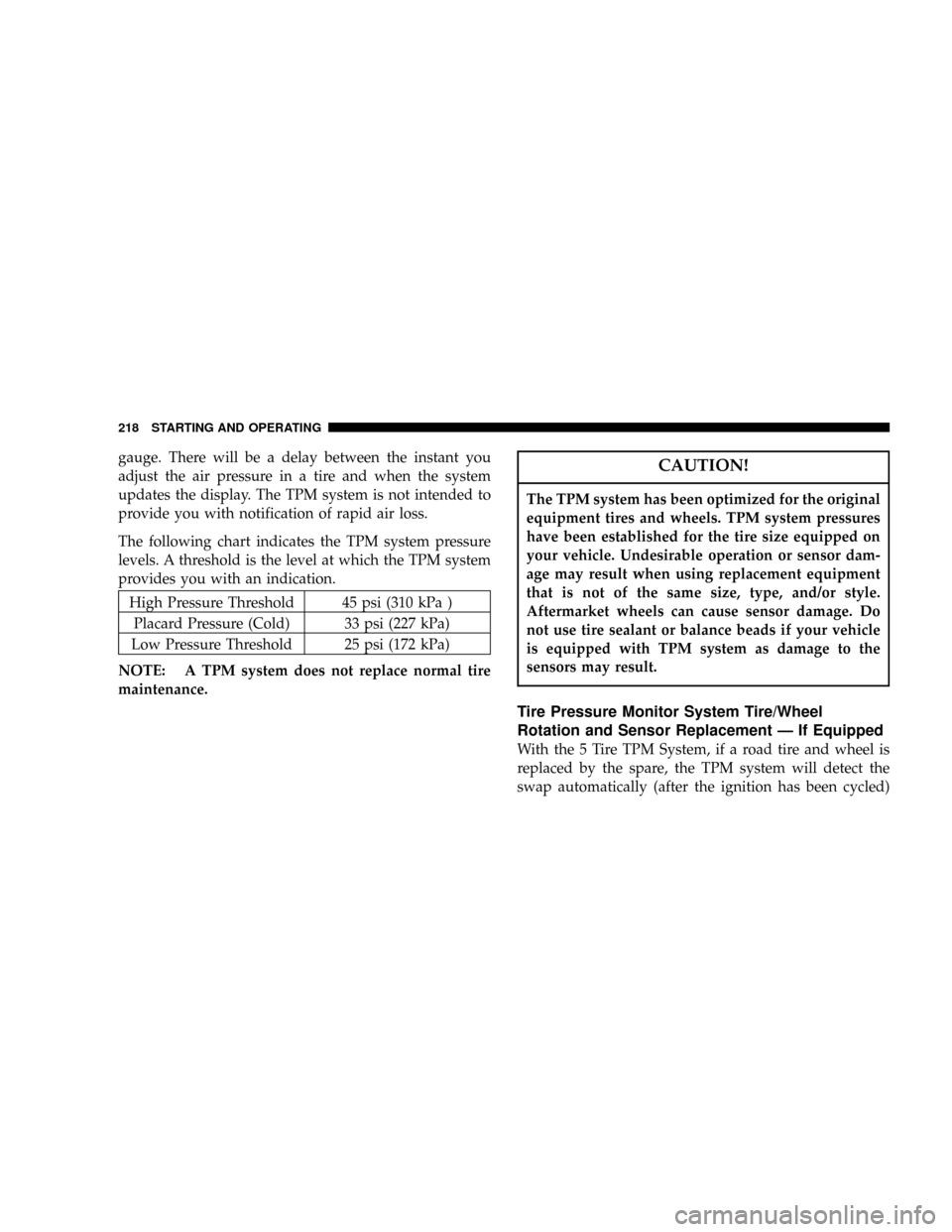
gauge. There will be a delay between the instant you
adjust the air pressure in a tire and when the system
updates the display. The TPM system is not intended to
provide you with notification of rapid air loss.
The following chart indicates the TPM system pressure
levels. A threshold is the level at which the TPM system
provides you with an indication.
High Pressure Threshold 45 psi (310 kPa )
Placard Pressure (Cold) 33 psi (227 kPa)
Low Pressure Threshold 25 psi (172 kPa)
NOTE: A TPM system does not replace normal tire
maintenance.
CAUTION!
The TPM system has been optimized for the original
equipment tires and wheels. TPM system pressures
have been established for the tire size equipped on
your vehicle. Undesirable operation or sensor dam-
age may result when using replacement equipment
that is not of the same size, type, and/or style.
Aftermarket wheels can cause sensor damage. Do
not use tire sealant or balance beads if your vehicle
is equipped with TPM system as damage to the
sensors may result.
Tire Pressure Monitor System Tire/Wheel
Rotation and Sensor Replacement Ð If Equipped
With the 5 Tire TPM System, if a road tire and wheel is
replaced by the spare, the TPM system will detect the
swap automatically (after the ignition has been cycled)
218 STARTING AND OPERATING
Page 219 of 344

and display SPARE SWAP DETECTED along with a
chime. This could take up to 10 minutes with vehicle
speed above 25 mph (40 km/h).
With the 4 Tire TPM System, if a road tire and wheel is
replaced by the spare, the TPM system will display TIRE
SENSOR BAD/MISSING. This is due to the spare tire not
being equipped with a tire pressure sensor. Once the road
tire is repaired and/or installed back on the vehicle with
the proper tire pressure the message will be removed.
This could take up to 10 minutes with vehicle speed
above 25 mph (40 km/h).
The tire pressure sensorsmustbe retrained following a
wheel rotation or sensor replacement. Refer to ªEVIC Ð
Retrain Tire Sensorsº in Section 3 for more information. It
is necessary to program the EVIC with the new sensor(s)
or the new position of each sensor as it is rotated to a
different corner of the vehicle.If a wheel rotation is not followed by the retrain proce-
dure, the system will not properly inform you of the
correct vehicle location of a low or high tire pressure.
General Information
This device complies with part 15 of the FCC rules and
RSS 210 of Industry Canada. Operation is subject to the
following conditions:
²This device may not cause harmful interference.
²This device must accept any interference received,
including interference that may cause undesired op-
eration.
The tire pressure sensors are covered under one of the
following licenses:
United States.....................KR5S120123
Canada........................2671-S120123
STARTING AND OPERATING 219
5
Page 220 of 344

TIRE CHAINS
Certain models have sufficient tire-to-body clearance to
allow use of tire chains.Install chains on rear tires only.
Follow these recommendations to guard against damage
and excessive tire and chain wear:
²Do not install tire chains or traction devices on ve-
hicles with larger than P225/75R16 size tires. These
tires are too large for sufficient body clearance with
chains or other traction devices.
²Use SAE class ªSº tire chains or traction devices only.
²Follow tire chain manufacturer's instructions for
mounting chains.
²Install chains snugly and tighten after 1/2 mile (1 km)
of driving.
²Do notexceed 35 mph (56 km/h), unless otherwise
specified by the chain manufacturer.
²Drive cautiously, avoiding large bumps, potholes and
extreme driving maneuvers.
TIRE ROTATION RECOMMENDATIONS
Tires on the front and rear axles of vehicles operate at
different loads and perform different steering, handling,
and braking functions. For these reasons, they wear at
unequal rates, and develop irregular wear patterns.
These effects can be reduced by timely rotation of tires.
The benefits of rotation are especially worthwhile with
aggressive tread designs such as those on On/Off Road
type tires. Rotation will increase tread life, help to main-
tain mud, snow, and wet traction levels, and contribute to
a smooth, quiet ride.
Follow the recommended tire rotation frequency for your
type of driving found in the ªMaintenance Schedulesº
Section of this manual. More frequent rotation is permis-
sible if desired. The reasons for any rapid or unusual wear
should be corrected prior to rotation being performed.
220 STARTING AND OPERATING